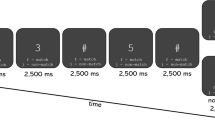Abstract
Abilities are usually assumed to exist in a “positive manifold.” Experimental manipulations of physiological variables, however, suggest that negative relationships exist between certain of the neural processes contributing to simple perceptual-motor vs. perceptual-restructuring tasks. First-order correlative evidence of this phenomenon cannot be obtained because the between-individual differences in general ability level tend to exceed the behavioral effects of the intra-individual opposition between neural processes. Also, since statistical removal of the “g” variance induces bipolarity in the remaining variance, the second-order negative correlations are necessarily regarded as artifactual. A combined correlational-experimental approach is suggested to overcome this difficulty.
Similar content being viewed by others
References
Broverman, D. M. Normative and ipsative measurement in psychology.Psychological Review, 1962,69, 295–305.
Broverman, D. M., Broverman, Inge K., Vogel, W., Palmer, R. D., & Klaiber, E. L. The automatization cognitive style and physical development.Child Development, 1964,35, 1343–1359.
Broverman, D. M., Klaiber, E. L., Kobayashi, Y., & Vogel, W. The roles of activation and inhibition in sex differences in cognitive abilities.Psychological Review, 1968,75, 23–50.
Callaway III, E., & Stone, G. Re-evaluating focus of attention. In L. Uhr & J. G. Miller (Eds.),Drugs and behavior. New York: Wiley & Sons, 1960, pp. 393–398.
Carlton, P. L. Some effects of scopolamine, atropine, and amphetamine in three behavioral situations.Pharmacologist, 1961,3, 60.
Dorfman, R. L., & Shipley, R. A.Androgens. New York: J. Wiley & Sons, 1956.
Fleishman, E. A. Development of a behavior taxonomy for describing human tasks: a correlational-experimental approach.Journal of Applied Psychology, 1967,51, 1–10.
Gainer, W. L. The ability of the WISC subtests to discriminate between boys and girls of average intelligence.California Journal of Educational Research, 1962,13, 9–16.
Hess, W. R.Diencephalon, autonomic and extrapyramidal functions. New York: Grune & Stratton, 1954.
Klaiber, E. L., Broverman, D. M., & Kobayashi, Y. The automatization cognitive style, androgens, and monoamine oxidase.Psychopharmacologia, 1967,11, 320–336.
Kohs, S. C.Intelligence measurement. New York: Macmillan, 1923.
MacMeeken, A. M.The intelligence of a representative group of Scottish children. London: University of London Press, 1939.
McCarthy, D. The language development of the preschool child.University of Minnesota Institute of Child Welfare Monograph, 1930,4, 174.
McNemar, Q.The revision of the Stanford-Binet Scale: An analysis of the standardization data. Boston: Houghton Mifflin, 1942.
Miele, J. A. Sex differences in intelligence: the relationship of sex to intelligence as measured by the Wechsler Adult Intelligence Scale and the Wechsler Intelligence Scale for Children.Dissertation Abstracts, 1958,18, 2213.
Norman, R. D. Sex differences and other aspects of young superior adult performance on the Wechsler Bellevue.Journal of Consulting Psychology, 1953,17, 411–418.
Podell, J. E., & Phillips, L. A developmental analysis of cognition as observed in dimensions of Rorschach and objective test performance.Journal of Personality, 1959,27, 439–463.
Ross, J. The relation between test and person factors.Psychological Review, 1963,70, 432–443.
Samuels, F. Sex differences in reading achievement.Journal of Educational Research, 1943,36, 594–603.
Schneidler, G. R. & Paterson, D. G. Sex differences in clerical aptitude.Journal of Educational Psychology, 1942,33, 303–309.
Schnell H. Sex differences in relation to stuttering: Part II.Journal of Speech Disorders, 1947,12, 23–38.
Spector, S. Monoamine oxidase in control of brain serotonin and norepinephrine content.Annals of the New York Academy of Sciences, 1963,107, 856–864.
Stroop, J. R. Studies of interference in serial verbal reactions.Journal of Experimental Psychology, 1935,18, 643–672.
Tanner, J. M.Growth at adolecence. (2nd ed.). Oxford, England: Blackwell Scientific Publications, 1962.
Thurstone, L. L. Unitary abilities.Journal of General Psychology, 1934,11, 126–132.
Thurstone, L. L.The vectors of mind. Chicago: University of Chicago Press, 1935.
Thurstone, L. L.A factorial study of perception. Chicago: University of Chicago Press, 1944.
Thurstone, T. W., Thurstone, L. L., & Strandskov, H. H. A psychological study of twins. 2. Scores of one hundred and twenty-five pairs of twins on fifty-nine tests. The Psychometric Laboratory, University of North Carolina, Chapel Hill, N. C., 1955, No. 12.
Tiffin, J., & Asher, E. J. The Purdue Pegboard: Norms and studies of reliability and validity.Journal of Applied Psychology, 1948,32, 234–247.
Wada, J. A., Wrinch, J., Hill, D., McGeer, P. L., & McGeer, E. G. Central aromatic amine levels and behavior.Archives of Neurology, 1963,9, 81–89.
Wechsler, D.Wechsler adult intelligence scale. New York: Psychological Corporation, 1955.
Witkin, H. A. Individual differences in ease of perception of embedded figures.Journal of Personality, 1950,19, 1–15.
Witkin, H. A., Dyk, R. B., Faterson, H. F., Goodenough, D. R., & Karp, S. A.Psychological differentiation. New York: John Wiley and Sons, 1962.
Author information
Authors and Affiliations
Additional information
This work was supported in part by the Dementia Praecox Research Project, Worcester State Hospital, and research grant HD 02557 from the National Institute of Child Health and Human Development, U. S. Public Health Service.
Rights and permissions
About this article
Cite this article
Broverman, D.M., Klaiber, E.L. Negative relationships between abilities. Psychometrika 34, 5–20 (1969). https://doi.org/10.1007/BF02290169
Received:
Revised:
Issue Date:
DOI: https://doi.org/10.1007/BF02290169




